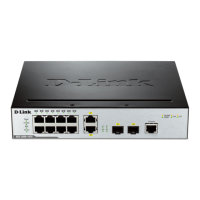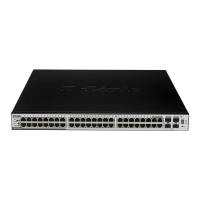DGS-3000 Series Layer 2 Managed Gigabit Ethernet Switch CLI Reference Guide
895
Appendix C
Trap Log Entries
This table lists the trap logs found on the Switch.
Trap Name Trap Description OID
risingAlarm
The SNMP trap that is generated when an alarm entry crosses its
falling threshold and generates an event that is configured for
sending SNMP traps.
Binding:
1.alarmIndex
2.alarmVariable
3.alarmSampleType
4.alarmValue
5.alarmFallingThreshold
1.3.6.1.2.1.16.0.1
fallingAlarm
The SNMP trap that is generated when an alarm entry crosses its
falling threshold and generates an event that is configured for
sending SNMP traps.
Binding:
1. alarmIndex
2. alarmVariable
3. alarmSampleType
4. alarmValue
5. alarmFallingThreshold
1.3.6.1.2.1.16.0.2
LldpRemTablesChange
A lldpRemTablesChange notification is sent when the value of
lldpStatsRemTableLastChangeTime changes. It can be utilized by
an NMS to trigger LLDP remote systems table maintenance polls.
Note that transmission of lldpRemTablesChange notifications are
throttled by the agent, as specified by the 'lldpNotificationInterval'
object.
Binding:
1.lldpStatsRemTablesInserts
2.lldpStatsRemTablesDeletes
3.lldpStatsRemTablesDrops
4.lldpStatsRemTablesAgeouts
1.0.8802.1.1.2.0.0.1
coldStart
A coldStart trap signifies that the SNMPv2 entity, acting in an
agent role, is reinitializing itself and that its configuration may have
been altered.
1.3.6.1.6.3.1.1.5.1
warmStart
A warmStart trap signifies that the SNMPv2 entity, acting in an
agent role, is reinitializing itself such that its configuration is
unaltered.
1.3.6.1.6.3.1.1.5.2
authenticationFailure
An authenticationFailure trap signifies that the SNMPv2 entity,
acting in an agent role, has received a protocol message that is
not properly authenticated.
1.3.6.1.6.3.1.1.5.5
linkDown
A linkDown trap signifies that the SNMP entity, acting in an agent
role, has detected that the ifOperStatus object for one of its
communication links is about to enter the down state from some
other state (but not from the notPresent state). This other state is
indicated by the included value of ifOperStatus.
1.ifIndex
2.ifAdminStatus
3.ifOperStatus
1.3.6.1.6.3.1.1.5.3
linkUp
A linkUp trap signifies that the SNMP entity, acting in an agent
role, has detected that the ifOperStatus object for one of its
communication links left the down state and transitioned into some
other state (but not into the notPresent state). This other state is
indicated by the included value of ifOperStatus.
Binding:
1.ifIndex
2.ifAdminStatus
3.ifOperStatus
1.3.6.1.6.3.1.1.5.4

